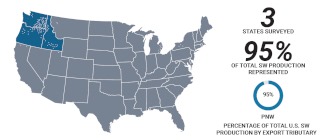The return to more normal growing conditions for the 2022/23 Pacific Northwest (PNW) U.S. soft white (SW) wheat crop offers typically performance in producing the world’s finest cakes, pastries, biscuits and snack foods.
Compared to the drought stressed 2021/22 crop, soft white this year has very weak to medium gluten strength and good finished product characteristics. Higher protein SW supplies provide opportunities in flour blends for crackers, Asian noodles, steamed breads, flat breads and pan breads. The SW subclass Club wheat, with very weak gluten strength, is typically exported as the subclass Western White, defined as a blend of more than 10% Club with SW, for cakes and delicate pastries.

The Season in Review